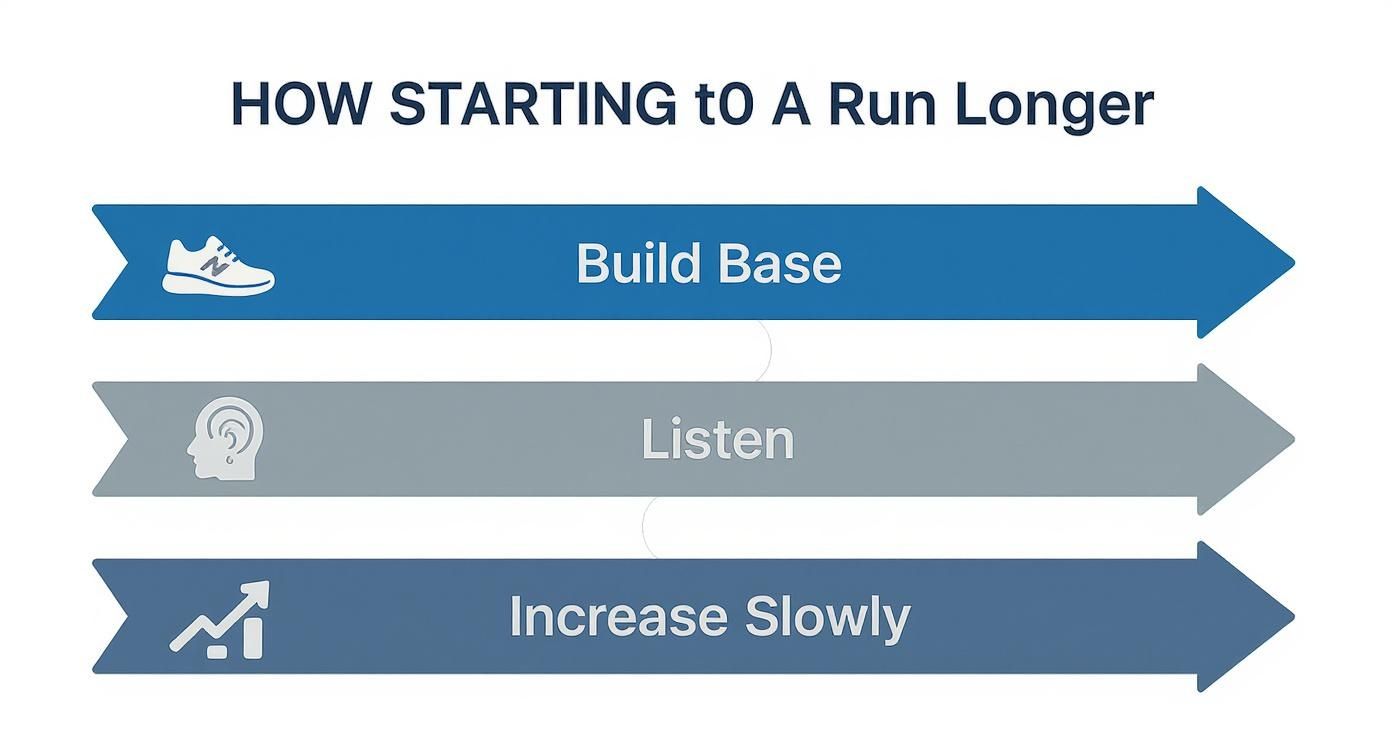So, you want to know how to run longer distances? The secret isn't some complicated formula or punishing workout plan. It's actually quite simple: build your aerobic base with consistent, easy-paced running.
Forget about pushing for speed for now. Your real goal is to gradually increase your "time on feet." This lets your body adapt safely, which is the absolute bedrock of long-term endurance and keeping injuries at bay.
Your Starting Point for Running Longer
Jumping into endurance training can feel like a lot, especially with all the confusing jargon and aggressive plans out there. But the truth is, real endurance isn't built on lung-busting sprints. It's forged with patience, consistency, and mastering the art of running slow. The main objective is to develop your aerobic system—think of it as your body's engine for any sustained, low-intensity effort.
This means the bulk of your runs should be at a "conversational pace." You know you're in the right zone if you could comfortably hold a chat with a running partner. This low-stress approach does wonders: it strengthens your heart, makes your body better at delivering oxygen to your muscles, and builds the resilience in your bones and muscles that you'll need to handle more miles down the road. Pushing too hard, too soon is the classic rookie mistake that almost always leads to burnout or injury.
The Foundational Pillars of Endurance Running
Before we get into the nitty-gritty of training plans, it's crucial to get a handle on the core principles that will guide your entire journey. These pillars aren't just suggestions; they're the non-negotiables that create a balanced, effective, and sustainable training structure. Getting these right will not only help you run farther but will make the whole process a lot more enjoyable.
Here’s a quick breakdown of what you need to focus on:
| Pillar | Why It Matters | Key Action |
|---|---|---|
| Aerobic Base Building | This is the foundation for everything. It trains your body to use oxygen efficiently and keep going for longer. | Dedicate 80% of your weekly runs to an easy, conversational pace. |
| Gradual Progression | Prevents overuse injuries by giving your muscles, tendons, and bones time to adapt to the new stress. | Stick to the 10% rule: increase your total weekly mileage by no more than 10%. |
| Consistency Over Intensity | Frequent, manageable runs build endurance far more effectively than a few brutal workouts here and there. | Aim for 3-4 runs per week, even short ones, to keep the momentum going. |
| Recovery and Rest | You don't get stronger while running; you get stronger when you rest. Recovery is where the magic happens. | Schedule at least one full rest day per week and prioritize 7-9 hours of sleep a night. |
Mastering these four areas is the key to unlocking your endurance potential safely and effectively.
Setting Goals That Actually Motivate You
Having a clear target in mind is a game-changer. It's not just fluff; data on global running habits shows that setting specific goals is a huge driver for improvement. For instance, an impressive 42% of runners have hit a new personal best in distances from the 5K to the marathon. This just goes to show how powerful a concrete target can be. You can dive deeper into these running trends and see what they mean for your own training.
So, instead of a vague goal like "run farther," get specific. For someone just starting out, a fantastic goal is simply to establish a consistent routine. You can build one out with a solid running schedule for beginners.
Key Takeaway: Your first job is to build the habit of running consistently. Don't get hung up on distance or speed yet. Just focus on getting out the door regularly. The endurance will come.
Building Your Endurance Engine
If you want to run farther, the secret isn't about gritting your teeth and pushing harder on every run. Forget raw speed for a moment. The real key is methodically building your body's capacity for endurance, turning it into a finely tuned, efficient engine. Your main goal right now is simply to accumulate "time on your feet" at a low, comfortable intensity. This teaches your body to become a fat-burning, oxygen-sipping machine.
This whole foundational phase is a masterclass in patience. You're not just logging miles; you're developing a stronger heart, growing denser capillaries to shuttle oxygen to your muscles, and fortifying the connective tissues that hold everything together. Pushing too hard, too soon skips over these crucial adaptations and is a fast track to burnout or injury.
Embrace the 80/20 Rule for Sustainable Progress
One of the most reliable strategies in a runner's toolkit is the 80/20 rule, sometimes called polarized training. It’s simple: 80% of your weekly running should feel genuinely easy and conversational. Only the remaining 20% should be dedicated to moderate or high-intensity efforts.
Following this rule helps you avoid the dreaded "grey zone"—that pace that feels kind of hard but isn't hard enough to spark major fitness gains. It just leaves you tired. By keeping most of your runs truly easy, you build a massive aerobic base and have the energy to really crush those key workouts when they pop up on your schedule.
This infographic breaks down the essential first steps for tackling longer distances.

As you can see, building your base, listening to your body, and progressing slowly aren't separate tasks—they're the interconnected pillars holding up your entire training plan.
The 10 Percent Rule: Your Injury-Prevention Insurance
I’ve seen it a thousand times: a runner gets excited about their progress and starts piling on the miles too quickly. This is one of the biggest mistakes you can make. Your muscles get stronger pretty fast, but your tendons, ligaments, and bones adapt on a much slower timeline. That mismatch is what leads to overuse injuries like shin splints and runner's knee.
The solution is beautifully simple: the 10 percent rule.
The guideline is straightforward: don’t increase your total weekly mileage by more than 10% from the previous week.
So, if you ran 15 miles this week, you'd aim for no more than 16.5 miles next week (15 + 1.5). This gradual, deliberate increase gives your entire musculoskeletal system the time it needs to catch up and get stronger, drastically cutting your injury risk.
Key Insight: Progress in distance running is measured in months, not weeks. Sticking to the 10 percent rule requires discipline, but it pays off with the consistency that truly makes you a better, stronger runner.
The Run-Walk Method: A Powerful Tool for All Runners
The run-walk method, pioneered by Olympian Jeff Galloway, often gets pigeonholed as a strategy just for beginners. That's a huge misconception. It's an incredibly powerful tool for any runner looking to tackle a new distance. The idea isn't to walk only when you feel exhausted; it's to incorporate planned, strategic walk breaks from the very beginning of your run.
By proactively mixing in walk breaks, you can:
- Reduce Overall Impact: Walking gives your joints and muscles a quick breather, lessening the cumulative stress of a long effort.
- Delay Muscle Fatigue: Those short breaks allow your heart rate to settle and help flush metabolic waste from your muscles, keeping you feeling fresher for longer.
- Speed Up Recovery: Runners who use this method consistently report feeling less sore after their long runs and bouncing back more quickly.
For example, you might start with a 4-minute run followed by a 1-minute walk, repeating that cycle throughout. It's a smart way to cover more ground with less physiological strain—the perfect recipe for building endurance safely.
Putting It All Together: A Sample Progression
Let's say you're comfortable running a 5K (3.1 miles) and have your sights set on a 10K (6.2 miles). A good training week is about more than just making one run longer; it's about building a balanced, sustainable schedule. For a deep dive, our comprehensive 10K training plan for 12 weeks provides a complete roadmap.
But to give you an idea, here’s what an early week could look like:
- Tuesday: 2 miles, easy conversational pace
- Thursday: 2.5 miles, easy pace, maybe add a few 30-second strides at the end
- Saturday: Long Run: 3.5 miles, very easy pace
- Mon, Wed, Fri, Sun: Rest or active recovery (think walking or stretching)
Following the 10 percent rule, the next week's total mileage would creep up to around 9 miles, with the long run stretching to maybe 4 miles. This slow, steady, and structured approach is the blueprint for building an endurance engine that will carry you to whatever finish line you're dreaming of.
Smart Pacing and Fueling for Long Runs

We've all been there—running out of gas halfway through a long run. It's frustrating, but it’s rarely a sign that you're not fit enough. More often than not, the real culprits are pacing and fueling, two of the most critical skills any runner needs to master. Get these right, and you'll completely transform your endurance.
The single biggest mistake I see runners make? Starting out way too fast. Adrenaline and fresh legs can trick you into pushing the pace, but you will absolutely pay for it later. Remember, the goal of a long run is to build endurance, not to set a new speed record.
Finding Your Ideal Long Run Pace
Your long run pace should feel genuinely comfortable and sustainable. We call this a "conversational pace" for a reason—you should be able to hold a conversation with a running partner without gasping for air. If you're running solo, try singing a few lines of a song. Can't get the words out? You're going too hard.
This low-intensity effort is where the magic happens. It teaches your body to become more efficient at burning fat for fuel, which saves your limited glycogen (carb) stores for when you really need them. It also strengthens your heart, muscles, and tendons without the high injury risk that comes with faster running.
A great way to practice this is by running negative splits. All this means is running the second half of your run slightly faster than the first. For a 6-mile run, you might cruise through the first 3 miles at a very relaxed pace, then pick it up just a touch for the final 3. It's a fantastic way to teach your body discipline and how to conserve energy.
Pro Tip: Start every long run feeling like the pace is almost ridiculously slow. Seriously. That patience at the beginning is exactly what allows you to finish strong instead of fading in the final miles.
Fueling Your Body for Endurance
As your runs get longer, you can't rely solely on the energy you have stored in your body. Proper fueling isn't just about what you eat during the run; it starts long before you even lace up your shoes. Think of your body like a car—you need a full tank to start a long trip, and you’ll need to top it off along the way.
For any run lasting longer than 60-75 minutes, you need a fueling plan. A good target is to take in 30-60 grams of carbohydrates per hour to keep your energy levels from crashing.
This doesn't have to be complicated. Here are some of the most common options runners use:
- Energy Gels: These are convenient, easy-to-digest shots of concentrated carbohydrates. They’re designed specifically for this purpose and are easy to carry.
- Energy Chews: Very similar to gels but in a gummy form. Some runners prefer the texture and find them easier to stomach.
- Real Food: Plenty of runners thrive on real food. Think dates, a few small boiled potatoes with salt, or half a banana.
The golden rule is to experiment on your training runs to find what your stomach can handle. The last thing you want is to try something new on race day!
Hydration and Electrolyte Balance
Hydration is just as crucial as calories. Getting dehydrated can sink a run in a hurry, leading to fatigue, cramps, and a nosedive in performance. While "drink to thirst" is decent advice for shorter efforts, you need to be more proactive on long runs.
When you sweat, you're losing more than just water—you're losing essential electrolytes like sodium, potassium, and magnesium. These minerals are what keep your muscles firing properly.
Here’s a simple hydration game plan:
- Start Hydrated: Make a point to drink plenty of water in the 24 hours leading up to your long run.
- Drink During: For runs over an hour, try to sip water or an electrolyte drink every 15-20 minutes.
- Replenish Electrolytes: Use sports drinks, electrolyte tablets, or salt capsules to replace what you're sweating out.
Pacing and fueling are skills that take practice. By dialing in your pace, figuring out your go-to fuel, and staying on top of hydration, you'll build the confidence and strength to go longer than you ever thought possible without hitting that dreaded wall.
Strength Training for Injury Prevention

If you want to run longer and stay healthy, your body needs to be more than just aerobically fit—it has to be resilient. A lot of runners fall into the trap of thinking that more miles are the only key to improvement, but they often forget about strength work. This is a fast track to frustrating, preventable injuries that can sideline you for weeks.
Think of it this way: your cardio is the engine, but strength training builds the chassis. It corrects muscle imbalances, dials in your running form, and makes your body tough enough to handle the constant pounding of thousands of foot strikes. The idea isn't to get bulky; it’s about building functional strength that directly supports your running.
Why Strength Is a Runner's Secret Weapon
Running is a high-impact sport. Every time your foot hits the ground, your body absorbs a force several times your own body weight. Without a strong network of supporting muscles, all that shock goes straight into your joints, tendons, and ligaments. This is exactly how common issues like runner's knee and IT band syndrome begin.
A smart strength routine fortifies these crucial areas, turning you into a more stable and efficient runner. When your glutes and hips are strong, for instance, they stop your knees from caving inward—a major cause of pain. A solid core acts as your body's anchor, preventing wasted energy from excessive twisting and helping you hold your form when you start to get tired. A stronger body is simply a more durable and efficient body.
A Stronger Core for a Better Run
Forget about doing hundreds of crunches. A runner’s core is a full 360-degree support system, wrapping around your abs, obliques, and lower back. This muscular corset is the foundation of good running posture, helping you stay upright and powerful, especially in the later stages of a long run.
A few foundational exercises can build a truly robust core for running:
- Plank: A classic for a reason. It engages your entire core. Aim for 3 sets, holding for 30-60 seconds.
- Bird-Dog: This move is fantastic for building stability and coordination. The key is slow, controlled movements while keeping your hips perfectly level.
- Glute Bridge: While it's a glute-focused move, it’s also brilliant for strengthening your lower back and core stabilizers.
Strong glutes are a runner’s best friend. They are the powerhouse of your stride. When they're weak, smaller, less-equipped muscles are forced to pick up the slack, which is a direct path to imbalances and injury.
Firing Up Your Powerhouse Muscles
Your glutes, hamstrings, and quads are the primary engines driving you forward. Building them up not only makes you a more powerful runner but also takes a massive amount of strain off your joints. When these big muscles are strong, they can handle a heavier workload without fatiguing—a non-negotiable as you start adding more mileage.
This is even more critical for runners tackling varied terrain. In recent years, activities like trail running have exploded in popularity. In fact, trail running participation in the US saw a 12.3% jump, with about 14.8 million people hitting the trails. Those uneven surfaces demand a ton from your stabilizing muscles, making strength work an absolute must.
To get started, try adding a few of these to your routine a couple of times a week:
- Squats: The gold standard for lower-body strength. Focus on keeping your chest up, back straight, and dropping your hips below your knees if you can.
- Lunges: These are perfect for building single-leg stability and strength, which directly mimics the motion of running.
- Deadlifts (bodyweight or light weight): An incredible exercise for the entire posterior chain—your hamstrings, glutes, and lower back all get work.
Building strength doesn't have to be complicated. Consistency with these fundamental movements is what builds lasting resilience. As they start to feel easier, you can add light weights or increase your reps to keep making progress.
This kind of targeted work is a game-changer for preventing common pains. For instance, many lower leg problems can be traced back to weakness higher up the chain. You can learn more about how to address this by reading our guide on how to prevent shin splints and see how these exercises fit into a broader prevention strategy.
Essential Strength Exercises for Runners
Here’s a simple weekly schedule you can follow to build foundational strength and mobility. Just 2 sessions a week can make a massive difference in your running.
| Day | Focus Area | Sample Exercises (3 sets of 10-12 reps) |
|---|---|---|
| Day 1 | Lower Body & Core | Squats, Forward Lunges, Glute Bridges, Plank |
| Day 2 | Full Body & Stability | Deadlifts, Reverse Lunges, Bird-Dog, Side Plank |
Remember to listen to your body and focus on good form over heavy weights or high reps. This simple addition to your week will pay huge dividends on the road, keeping you strong, healthy, and running for the long haul.
Mastering the Mental Game of Endurance
Your physical training builds the engine, but when you’re deep into a long run, it’s your mind that’s really steering the ship. We’ve all been there. Your legs feel like lead, your lungs are burning, and that little voice in your head starts whispering how great it would be to just stop. Learning how to run longer is as much about managing this mental chatter as it is about building physical stamina.
Think of endurance as a mental muscle. You can train it, just like you strengthen your legs. Elite ultrarunners don't psych themselves out by staring down a 100-mile race as one single, impossible task. They break it down into manageable pieces: just get to the next aid station, make it to that big oak tree, run for another 10 minutes. It's a surprisingly powerful technique that any runner can use.
Break It Down, Don't Break Down
The thought of heading out for a 10-mile run can feel completely overwhelming before you even lace up your shoes. So don't focus on the intimidating total. Shrink your world.
Your only goal is the mile you're in right now. Or maybe it's just getting to the next stop sign. This "chunking" method turns one massive challenge into a series of small, achievable victories. Each time you hit one of these mini-goals, you get a little mental boost, a feeling of accomplishment that gives you the fuel to tackle the next one. It’s a simple mind trick, but it can completely reframe a tough run.
Build Your Mental Toolkit
When the discomfort really sets in, you need to have some go-to strategies ready. If you wait until you're already desperate to quit, it's often too late. You have to train your brain to respond proactively, just like you train your body.
Here are a few proven techniques to build that mental toughness:
- Visualization: Before your run, spend a few minutes picturing yourself out on the road. See yourself moving smoothly, feeling strong, and cruising through your planned distance. When things get tough later, call up that positive image to remind your brain what success feels and looks like.
- Positive Self-Talk: The voice in your head can be your worst critic or your best coach. You get to choose. Actively shut down negative thoughts like "I can't do this" and replace them with something constructive like, "This is tough, but I am stronger."
- Find a Mantra: Come up with a short, powerful phrase to repeat when you're in the pain cave. It could be something as simple as "strong and steady," or "one foot at a time." A good mantra gives your brain something to focus on and helps drown out the negativity.
This kind of mental practice isn't just for the pros; it's a huge reason why everyday runners are getting faster. After a dip during the pandemic, marathon participation has rebounded in a big way. What’s really interesting is that average marathon finish times are improving for the first time in decades, which suggests people are training and racing smarter than ever before.
The Big Idea: You win the mental battle in small increments. Focus on the present moment and use tools like visualization and mantras to override the urge to stop. This is how you push through temporary discomfort and unlock new levels of endurance.
Fall in Love with the Process
It's so easy to get fixated on a specific race day goal or a new distance PR. And while goals are great, real, long-term motivation comes from finding some joy in the day-to-day process. Some runs will feel amazing. Others will be a total grind. That’s all just part of it.
Try to appreciate the quiet morning miles, the feeling of your fitness building week by week, and the simple act of moving your body. When you learn to love the process of running itself, the motivation to go farther follows naturally. You'll start running longer not because you have to, but because you've built a mindset that truly enjoys the challenge.
Got Questions? We've Got Answers
As you start pushing your limits and adding more miles, you're bound to have some questions pop up. It happens to every runner. Let's tackle some of the most common ones I hear from athletes building up their endurance.
How Often Should I Be Doing a Long Run?
For almost everyone aiming to run farther, the sweet spot is one dedicated long run per week. Think of this as the non-negotiable, cornerstone session of your training week. It's the run that really prods your body to make those crucial physiological changes needed to handle more mileage.
The golden rule? Keep that long run pace genuinely easy. You should be able to hold a conversation without gasping for air.
A classic mistake is thinking more is always better and trying to cram in multiple long, hard runs. That's a fast track to burnout and injury, which will only derail your progress. The rest of your weekly runs should be shorter, supporting that main effort through base maintenance or active recovery.
What's the Right Way to Breathe When I'm Running?
The best way to breathe is to go deep—I'm talking about diaphragmatic breaths, or "belly breathing." So many runners get stuck in a pattern of shallow chest breathing, which seriously limits how much oxygen you get and is a common culprit behind those dreaded side stitches.
To get it right, focus on breathing in through both your nose and mouth to pull in the maximum amount of air. You should feel your stomach expand outward on the inhale, not just your chest puffing up.
A great little trick is to sync your breathing to your footsteps. For example, try inhaling for three steps and exhaling for two. Practicing this even when you're just walking around or sitting on the couch can help it become second nature when you're out on the road.
My Two Cents: Think of breathing as a skill you can train. If you consciously practice deep belly breaths during your easy runs, your body will eventually do it on autopilot when you're tired. It makes a world of difference in how controlled and comfortable you feel.
Should I Focus on Running for Time or for Distance?
When you're just starting to build endurance, running for a set amount of time is almost always better than chasing a specific distance. This simple shift in mindset changes the goal to "time on your feet," which is what truly builds a solid aerobic base.
Fixating on hitting a certain number of miles can tempt you to push the pace, especially when you're feeling good. That adds a lot of unnecessary stress. Instead of setting out to run 5 miles, try running for 50 minutes at an easy, sustainable effort.
This approach encourages you to tune into your body and keep the intensity low, which is exactly what you need to develop endurance. Once you're more seasoned and maybe start thinking about a specific race, you can begin weaving more distance-based goals back into your plan.








